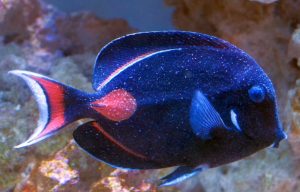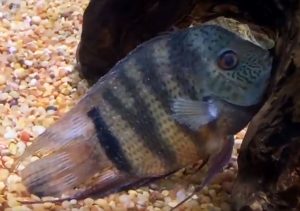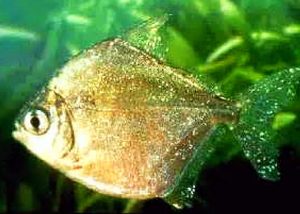Velvet Disease (Oodinium pillularis) known to tropical fish keeping enthusiasts as Gold Dust, Coral, or Rust Disease is caused by a protozoan that has a life cycle similar to Ichthyophthiriasis multifiliis (white spot disease). Velvet is actually a round or pear shaped dinoflagellate that attacks both freshwater and marine tropical fish and can cause death when not treated promptly.
The parasite usually attacks the gills of the fish first before moving to the rest of the body and fins. When it appears on the head, fins, and body of the fish as small, yellowish spots that give it a “dusty” appearance, the infestation is already severe. Infected fish usually exhibit a dusty, brownish gold color.
Different Oodinium species include: pillularis, cyprinodontum, limmeticum, and ocellatum. Oodinium ocellatum is particular to marine fish.
LIFE CYCLE:
Although Velvet Disease (Oodinium pillularis) is similar to White Spot Disease (Ichthyophthiriasis multifiliis) and has a similar life cycle; Oodinium pillularis is a flagellate, and Ichthyophthiriasis multifiliis is a ciliate.
Velvet Disease (Oodinium pillularis) has a life cycle that is temperature dependent, typically 6 to 12 days long however, at lower temperatures it can be as long as 28 days.
The motile Oodinium dinospore swims around the water column looking for a suitable host fish species to attach itself to.
When it finds a host, it attaches itself by rooting into the skin or gills of the fish where it forms a hard shell (cyst) that protects it while it absorbs nutrients from the fish.
In this Trophont cyst stage, which is the only stage that you can actually see Oodinium pillularis on the fish, it continues growing and dividing until it looks like a fine dust covering the skin.
After a few days on the fish, the Oodinium pillularis cyst detach themselves and fall to the bottom where after a 3 to 28 day incubation period they begin to divide free into a new generation of dinospores.
During the incubation period on the bottom of the tank, a protective shell forms on the inside, which allows the reproduction by cellular division of more than three hundred dinospores.
The free swimming dinospores are vulnerable and must attach themselves to a new host within 48 hours or so or they will die.
PHYSICAL SYMPTOMS:
Velvet disease symptoms vary according to the severity of the infection.
During initial stages of the infection, the affected fish will show some behavioral changes like fin twitching, rapid respiration, appetite loss, clamped fins, flashing or body rubbing.
The “flashing” behavior or scraping on the substrate is simply the fish trying to rid itself of the parasite.
As the Velvet parasite multiplies and the disease advances, the eyes become clouded, the fins are peppered, and the body looks like it has been dusted with gray to yellow colored powdered sugar. The reason the skin of the sick fish becomes dusty and opaque is due to the excess amount of mucus that their immune system generates as a defense mechanism.
The faded, velvety looking body areas if left untreated, will slough off the protective slime coating of the fish and eventually cause death.
Because the Oodinium parasite affects the gills, respiratory failures are common occurrences, and when the gills are severely damaged, death can occur in as little as 12 hours.
When condition becomes severe, the fish may exhibit the following:
- Opaque eyes
- Protrusion of the eyeballs
- Fins against the body
- Ulcers in the skin
- Skin detachment
- Pathological Physiology
CAUSE:
The most common cause of Velvet disease is poor aquarium maintenance and not quarantining new fish. The following can also attribute to the disease:
- Sudden changes in water temperature
- Introduction of infected fish without quarantining
- Introducing tired fish that are lacking in defenses into a tank
- Old dirty water. You should perform frequent water changes in your tanks.
- Introduction of infected plants
TREATMENT:
Because Velvet is highly contagious and usually in it’s advanced stage before being diagnosed, treatment should begin as soon as possible. All treatment regimens are targeted at the free swimming (tomite) stage of the parasite.
- TREATMENT – FRESHWATER:
- Increase the water temperature
Raising the temperature in the tank to 82 degrees F or higher will speed up the life cycle of Oodinium and treat the infestation faster. - Add aquarium salt to the tank
Adding salt to the water at a rate of 1 to 3 level teaspoons per gallon increases the mucus production of the fish, reduces the osmotic stress, and helps ward off the parasite. - Dim the lights for several days
Because Oodinium is light dependent, dimming the aquarium lights helps to eliminate the degree of infestation. - Treat the system with copper sulfate for ten days
Copper sulfate is the treatment of choice for Velvet disease. Follow the manufacturer’s instructions and treat the aquarium for a full ten days to ensure that the parasite is completely eradicated. - Atabrine (quinacrine hydrochloride) is another effective medication that is often used to treat Velvet.
- Discontinue carbon filtration during treatment
Because activated carbon removes drugs from the water, remove all activated carbon or charcoal from the tank being treated.
- TREATMENT – SALTWATER:
- Because the Velvet parasite has semipermeable membranes and cannot control osmosis, an immediate drop in salinity can effectively control Oodinium in saltwater environments. The Oodinium ocellatum parasite begins to absorb water as the cells try to equalize osmotic pressure with the sudden change and most strains will pop like a balloon as they fill with too much water.
- Fish and several other sea creatures can withstand and adjust to this change in osmotic pressure, but protozoan (White Spot and Clownfish Disease), dinoflagellate (Velvet or Coral Fish Disease), and flatworm (Black Spot Disease) organisms cannot.
- Monitored hyposalinity (1.010-1.013) in fish only tanks will enhance the effectiveness of most treatments. Hyposalinity should NEVER be used in reef systems. It will kill corals and inverts.
- Repeated 10 to 15 minute fresh water baths medicated with quick cure
or formalin
will cause the trophants on the infected fish to dislodge themselves. Make sure to net the fish from the tank quickly or the stress of handling can do more damage than the cure.
- Like the Ick parasite, raising the water temperature will increase the reproduction rate of Oodinium, shorten the life cycle, and decrease the treatment time, however, the metabolic rate of the fish and their demand for oxygen also increases. Add several air stones to the tank being treated.
- Cupramine
(copper sulfate) treatments are a very effective treatment for Velvet disease. Treat the fish for 20 to 30 days.
- Chloroquine phosphate treatments are also used to successfully treat Velvet disease.
- Rally
and Hypercure
are “reef safe” medications that are considerably weaker, but are reported to work well.
- Anti-parasitic foods and garlic additives
to the fish food will also help if the fish is eating. Garlic infused foods improve the appetite of marine and freshwater fish.
PREVENTION:
Because most medications for the Oodinium flagellate will kill coral and live rock, prevention is the best treatment for Velvet disease, especially in reef tanks.
Velvet disease is a common occurrence in aquariums with poor maintenance. Avoid the following:
- Abrupt fluctuations in water temperature
- Introducing new fish without quarantining them
- Keeping old water in the tank. Maintain frequent, regular water changes.
- Introducing marine plants with cysts. When bringing in new plants, make sure to isolate and disinfect them if possible prior to introduction.
Having the right equipment to house your fish in a pristine marine environment prevents most marine diseases.
Buy a good filtration system, protein skimmer, and UV sterilizer
; quarantine all new fish, feed them a varied nutritious diet and the chance of getting Oodinium ocellatum is virtually nil.
Because Velvet disease can happen so quickly, many tropical fish keeping enthusiasts have lost an entire tank in only a day or two before ever diagnosing the disease.





